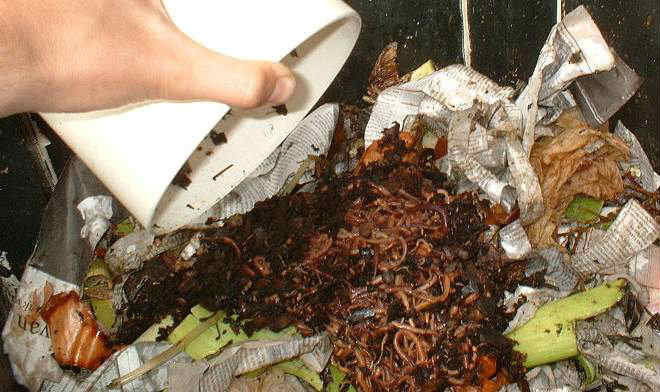According to scientists at the Ecology and Environment Division, Forest Research Institute in India, “management of solid waste has become one of the biggest problems we are facing today. The rapid increase in the volume of waste is one aspect of the environmental crisis, accompanying recent global development.” In addition, degraded soils are a problem throughout the world. Worm composting, or vermicomposting, is an innovative way to address the increase in waste by turning organic matter into nutrient-rich compost for soils, as opposed to dumping waste in landfills. It can be done by home gardeners, farms of various sizes, and in large commercial operations.
Vermicompost can have a number of benefits for soils. As primary consumers in the composting process, earthworms eat organic matter such as food particles and plant debris which they then convert to compost in which nutrients are more easily available to plants. Vermicompost can improve soil structure and soil fertility by increasing porosity and aeration and improving soil moisture-retention, all of which can help increase crop yields. Adding vermicompost to soil can increase microbial organism activity by up to 20 times higher than soil that has not been amended.
Vermicomposting can be done both indoors and outdoors, which means it can be done year-round, an advantage for home gardeners and small-scale farmers. It requires few materials: just a container, worms, moist bedding, and organic matter such as food waste. Managing the process does require some care in terms of providing worms the ideal amount of organic matter and maintaining the ideal amount of moisture in the compost pile. The end product can be used to amend potting soil, used as mulch, as a lawn conditioner, or added to water, which is then used to water plants. Vermicomposting also produces an excess liquid which can be captured and used as a liquid plant fertilizer.
The worms need to be fed organic matter such as fruit and vegetable peels, eggs shells, tea bags, and coffee grounds while avoiding harder-to-digest and vermin-attracting matter such as meat, dairy, oily foods, and grains. They can also process nitrogen-rich manures. According to the Cornell Waste Management Institute “the matter passes out of the worm’s body in the form of casts, which are the richest and finest quality of all humus material. Fresh casts are markedly higher in bacteria, organic material, and available nitrogen, calcium, magnesium, phosphorus and potassium than soil itself.”
There are numerous types of worms which can be effective vermicomposters, depending on local conditions. The scientific names for two commonly used and effective species are Eisenia foetida and Lumbricus rubellus. As vermicomposting has become more common, the biotechnology field has invested more heavily in the research and development of vermiculture, which is the breeding and propagation of earthworms. By treating waste as a useful resource and simulating the natural behavior of worms, “vermiculture provides for the use of earthworms as natural bioreactors for cost-effective and environmentally sound waste management.”
Here is one useful resource on how to vermicompost.
Sign up for Food Tank’s FREE Weekly Newsletter. More than 110,000 Subscribers And Counting. Click HERE to join.















